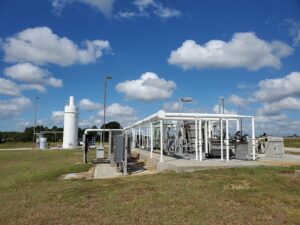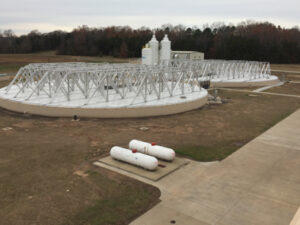What Neutralizes Ammonia Odor? A Side-by-Side Look at Real Treatment Methods
 Ammonia odor can cause serious problems in industrial and municipal facilities. It’s more than just unpleasant. Ammonia is a strong-smelling gas that can trigger complaints from nearby communities, raise health concerns for staff, and lead to regulatory trouble if left unchecked.
Ammonia odor can cause serious problems in industrial and municipal facilities. It’s more than just unpleasant. Ammonia is a strong-smelling gas that can trigger complaints from nearby communities, raise health concerns for staff, and lead to regulatory trouble if left unchecked.
One question we hear often is, “What neutralizes ammonia odor?” The truth is, there isn’t one answer that works for every site. Different systems need different approaches. At Webster Environmental Associates (WEA), we help facilities look at the facts and choose a method that fits their specific situation. Below, we compare three of the most common and reliable ways to control ammonia odor.
Option 1: Chemical Neutralization
Chemical treatment is often the first option people consider when ammonia becomes a concern. There are two main types of chemical systems used to neutralize ammonia odor: acid scrubbers and oxidation systems.
In acid-based chemical scrubbers, ammonia gas is absorbed into a water solution that contains a weak acid—often sulfuric acid. The acid reacts with ammonia to form ammonium salts, which do not have an odor. This method is common at sites with high ammonia levels or when quick results are needed.
Another option is hydrogen peroxide (H₂O₂). This chemical reacts with ammonia and other odor compounds to break them down. We typically inject H₂O₂ into the liquid stream upstream of known odor release points, such as pump stations or headworks. This helps stop the smell before it forms.
Chemical neutralization works fast and removes a high percentage of ammonia from the air. But it does come with some tradeoffs. You need to safely store the chemicals, and staff must be trained to handle them. There are also higher costs for chemical supply and system maintenance.
Option 2: Biological Odor Control
Biological systems, such as biofilters and biotrickling scrubbers, use naturally occurring microorganisms to break down odor compounds. These systems are best for steady, moderate ammonia levels. They’re often used at wastewater treatment plants, food processing sites, and solid waste facilities.
In a biofilter, odorous air is pushed through a bed of media—such as compost, wood chips, or engineered materials. The microbes living on the media absorb and break down ammonia and other compounds. Biotrickling scrubbers operate similarly but use a recirculating liquid stream and synthetic media to maintain better control over conditions.
These systems are generally more sustainable than chemical scrubbers. They use fewer resources, generate less waste, and have lower operating costs over time. But they do require stable environmental conditions. The microbes need consistent airflow, moisture, and pH levels to stay active. If those things aren’t maintained, performance drops.
Option 3: Airflow and Containment Strategies
 In some cases, the problem isn’t just the amount of ammonia—it’s how and where it escapes. That’s where airflow and containment strategies come in. These systems focus on capturing ammonia at the source before it spreads.
In some cases, the problem isn’t just the amount of ammonia—it’s how and where it escapes. That’s where airflow and containment strategies come in. These systems focus on capturing ammonia at the source before it spreads.
At WEA, we often use enclosures or covers to isolate equipment or processes that emit ammonia. From there, we direct the air into an odor control unit, such as a scrubber or biofilter. This setup works well for areas like open tanks, transfer points, or processing buildings where it’s hard to seal everything completely.
This approach is often used alongside another method. It doesn’t remove the odor by itself, but it helps treatment systems work better by collecting the air more efficiently.
How WEA Guides Selection
Every facility is different and has different needs when it comes to industrial odor control. A system that works well at one location might fail at another. That’s why we never recommend a treatment method without looking at the full picture.
We start with testing. That includes air and liquid sampling, odor panel evaluations, and compound concentration measurements. We also look at the layout of the site, the types of emissions, and the flow conditions.
Once we understand the conditions, we help compare different methods side by side. We talk through the pros and cons and help decide which option—or combination of options—fits best. For some clients, that might mean installing a chemical scrubber. For others, it might be a biofilter and enclosure working together.
In many cases, a layered approach gives the best results. We stay involved through the design process and can also provide support with installation and long-term maintenance.
Thinking About Ammonia Odor? Let WEA Help
If your facility is struggling to figure out what neutralizes ammonia odor, you’re not alone. It’s a common issue in wastewater, food processing, and other industries. But with the right tools and data, it can be managed effectively.
There’s no single system that works for everyone. That’s why our job at WEA is to help you find the best fit for your site—not just recommend what’s easiest to install.
We’ve worked with hundreds of facilities dealing with odor control challenges. Whether you’re planning a new system, upgrading an old one, or just need help figuring out what’s wrong, we’re here to help.
Contact us to schedule testing or talk about treatment options. We’ll help you build a plan that works—for your team, your budget, and your community.
